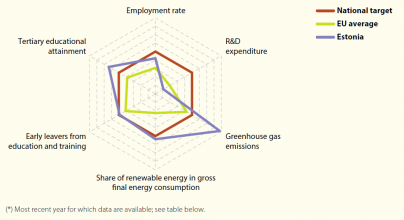Archive:Europe 2020 indicators - Estonia
- Data from July 2013. Most recent data: Further Eurostat information, Main tables.
This article is part of a greener, more inclusive - indicators to support the Europe 2020 strategy set of statistical articles based on the Eurostat publication Smarter, greener, more inclusive? - Indicators to support the Europe 2020 strategy. It provides recent statistics on the Europe 2020 strategy of the European Union (EU), focusing on the situation in Estonia.

Main statistical findings

Estonia exceeded both its targets on GHG emissions and renewable energies. While the GHG emissions were targeted to increase by no more than 11 % compared with the 2005 level, in 2010 an increase of only 6 % was recorded. Similarly, the share of renewable energies in 2011 amounted to 25.9 %, compared to the target of 25 %. Although progress is still needed to achieve its other Europe 2020 commitments, Estonia is closer to its targets than the EU average for employment, R&D expenditure, tertiary education and early school leaving. The share of the population at risk of poverty after social transfers has stagnated at 17.5 %, which implies further efforts are needed to reach the national target of 15 %.
Data sources and availability
More information about the origin of the data and the calculation of indicators can be obtained via the Europe 2020 indicators dedicated website.
Under 'Tables', click on the icons next to the indicators:
- 'Explanatory texts (metadata)' for a detailed overview of the collection and compilation methods;
- 'Information on the leaf' for data availability per country.
A more general overview of quality procedures can be found in Implementation of standard reference metadata for indicators - the ESMS Indicator Profile (ESMS-IP) (PDF file).
Context
Measures implemented to meet the national targets
- Employment: Introducing reforms in the social benefit system in order to improve incentives to work; reducing the workforce tax burden; increased provision of labour market and related services; increased flexibility in the allocation of disability, unemployment and parental benefits; incentives for the integration of the young and long-term unemployed in the labour market.
- Education: Measures aimed at improving the quality, availability and effectiveness of education and ensuring more effective tailoring of education and training to the needs of the labour market; adoption of a new Lifelong Learning Development Plan for improving access of low-skilled workers to life-long learning; higher education funding reform with greater focus on performance in order to raise general quality of the education system.
- R&D expenditure: Development of a new R&D and innovation strategy and an entrepreneurship growth strategy focusing on the business sector. The strategies aim to achieve smart global specialisation in the fields of R&D and entrepreneurship; support for the internationalisation and infrastructural development of the Estonian R&D sector.
- Renewable energies: Promoting renewable energy use by implementing improvements in infrastructure and legislation.
- Energy efficiency and resource efficiency: Measures to support improvement in energy efficiency, in particular in buildings and transport; additional investments in the renovation of public buildings and the modernisation of public transport, modernisation of urban lighting; adoption of a new strategic waste management plan, etc.
The European Commission's 2013 country-specific recommendations
- Employment: Strengthening of active labour market policies is needed in order to tackle the high structural unemployment in the country; provide incentives to work by increasing the flexibility and targeting of social benefits; further improvements in the delivery of social services, including childcare, are also necessary.
- Education, research and innovation: More emphasis should be placed on improving the link between education and training systems and the labour market; further steps should be taken in increasing the participation of low-skilled workers in life-long learning; support the internationalisation of research and innovation systems and promote the cooperation between business, education and research institutions.
- Energy efficiency: There is still considerable scope for improvement in the energy efficiency of buildings and the transport system; take further measures for strengthening environmental incentives for vehicles and waste; diversify energy sources and promote competition in the energy market by developing cross-border energy networks.
- Others: Sustain the strong budgetary position while introducing the structural budget balance rule as established by the Treaty and complementing it with more binding expenditure targets; introduce reforms in local governments to improve the efficiency and quality of local public service provision.
See also
Further Eurostat information
Publications
- [[Smarter, greener, more inclusive - indicators to support the Europe 2020 strategy] (online publication, also downloadable as PDF file)
Main tables
Dedicated section
Methodology / Metadata
- Towards robust quality management for European Statistics - Communication from the Commission COM(2011) 211 final
Other information
- Regulation 223/2009 of 11 March 2009 on European statistics